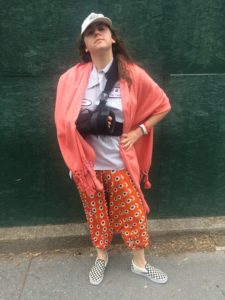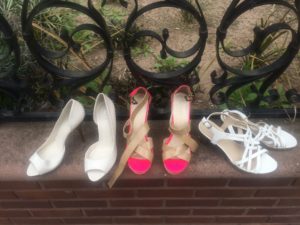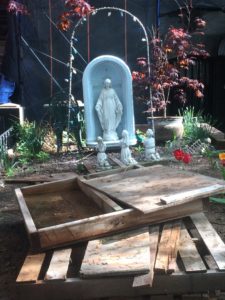I was encamped in Carroll Gardens, a gentrified segment of Brooklyn, to tend to our daughter Sarah as she recovered from reconstructive surgery on her labrum, the piece of cartilage that keeps the arm ball in the shoulder socket. Sarah’s labrum was torn in two places as a result of the extreme extensions folded into her choreography. By the time she went under the knife, only her muscle training was keeping her arm in place. The surgeon had shown her he could push it out using just his thumb.
Now, post-surgery, her arm in a sling and on heavy painkillers, she couldn’t lift anything, not even a soda can. Her surgeon had had to stitch it just right, as in the Goldilocks story: Too tight and she’d lose the range of motion necessary to dance; too loose and the arm would eventually fall out of the ball socket again. She knew what that felt like. More than once she had had to pop it painfully back in herself, each incident a pathway to more tears.

I include the surgery image to emphasize that knowing where and how tight to sew up this cartilage bumper is not like getting a dead fly out of pudding. You have to be an artist, the surgeon admitted. It would only be later, after months of physical therapy, that she would know whether it worked, whether he’d reached that unspecifiable tautness. For now, all I could do was feed her, clothe her, and even bathe parts of her with my eyes shut.

Every day we would take short, ambling walks in this well-kept neighborhood, the tree buds starting to pop, magnolia blossoms unsheathing their pinkness above us. There were two things that struck me on those slightly chilly walks. The first was the number of shoes, women’s and children’s shoes—nice shoes—left out on the steps or the sidewalk’s edge for people to take away. I have always been haunted by single shoes in the street, left behind by somebody running in fear or passion to get away from or toward somebody, an involuntary trace of an intense scene we cannot see. But these were pairs, left together, sometimes in little groups, for others to take, invitations to walk in their shoes, offers for you to be like me. I understood them as tiny acts of grace, like breadcrumbs left for squirrels, empty returnable beer bottles left hanging in a plastic bag on the chain-link fence so that scavengers didn’t have to paw through the trash, or chubby historical novels left in a pensione for the next reader. They made me happy. I thought they might have something to do with Easter, which was upon us.

Carroll Gardens is named for Charles Carroll, the only Catholic signatory to the Declaration of Independence. It had housed generations of Irish and then Italian immigrants, whose young sons had also fought each other here for honor and turf. When I got my hair cut by a hairdresser who had lived here for three decades, she let me know she thought these proffered shoes were soulless compared to the way the Italian residents once showed generosity to their neighbors. They used to feed them, she chided me; they gave them plates of cooked food. Indeed, a few days before my haircut with her, the local bakery had put out a huge table of fresh-cut loaves for passersby to take on Easter weekend. The shoes, she thought, were just lazy castoffs of the new rich residents who wanted an easy way to give things away.
When she discovered where I lived, she really let loose her judgment on the source of my overestimation. Los Angeles, she opined, was an aggressive place lacking in kindness. “Even the lesbians,” she declared, “can look at you with such hostility.” She recalled a moment there, left briefly alone by her husband, when a woman sitting at a nearby table had stared her down. It had felt mean and aggressive. She had wanted, she said, “to sink into the floor.” I was, I thought she was telling me, blind to what was no longer before my eyes, coming as I did from a world where gift-giving had atrophied and identity trumped humanness. Inferring the invisible from the visible is ordinary table politics. Love affairs and wars start the same way.

But the images that really kept returning to me were the statues of the Holy Family in people’s front yards. The figurines looked outward, not inward. They were on every block, keeping watch over the passersby, announcing that here lived children of God. These were not small items tucked in a corner. They were large, centered announcements that the residents count themselves, and want to be counted, consubstantial with the incarnated Christ. Through painted plaster and concrete forms, cossetted with flowers, tiny bulbs, and palm fronds, these residents wanted everybody to know that they saw each other and themselves through the eyes of Jesus and his Mother. They wanted to see others seeing and being seen just like them. Everybody and everywhere: Catholic.
Eventually I left my daughter to fend for herself with one arm and a freezer full of Trader Joe’s precooked meals and flew back to California. Yet I couldn’t get those statues out of my head. They were not to be found on the streets where I live. In our nation’s abstract space of citizenship, a land not decorated with sites where the divine has broken through, they were kind of unbelievable, a tattoo on the land, a material integer of its particular place. Here were people displaying their belief in something nobody can see, forming it into large, colored statuary on their front lawns. That’s the whole point: to see through the plaster, the invisible through the visible, God through Jesus. Your eyes are not meant to stop on the plaster surface. It reminded me of the way my father used to swear in public. The people who got stuck on the words—and there were many—missed the poetry.
Social theorists like to look behind things, not through them: to reduce this to that. Through their refined aesthetics, for example, it is said the bourgeoisie manifest their distance from necessity. Beauty as power in drag. Dreary stuff like that. In our perpetual peep show, we make objects like these lawn statues into signs of membership, markers of group identity and territory, conventions, artifacts, and genres of material culture. Academics like me tend to be embarrassed by them, not unlike the way the Lutheran Max Weber saw the sacramental bits of the Latin Mass as residues of instrumental magic, not at all the hallmarks of an ethical monotheism applicable to all. We moderns are supposed to be beyond magical rites.
Weber, I think, was wrong. He believed that the capitalist states had ushered in an objectified, disenchanted world in which values were subjective commitments outside the object world obeying laws of its own. You had to personally hold to values with all your will as though your life depended on it and never mind the consequences. The ethical, the artistic, and the loving self stood against the lawful consequences of an interobjective modern world, a metaphysics laid over and often against a social physics. The object world was just there. But my reading about the rise of options trading, accounting conventions, and even money does not suggest that at all. As an absconded presence, the host has nothing on synthetic CDOs.
I have increasingly come to believe that statues like these are pervasive in every domain of our apparently profane existence. Our institutional lives are lived through objects whose efficacy depends on nonphenomenal goods, objects that depend on a thisness that nobody will ever see nor hear nor touch, but is immanent in the material practices they afford.1Roger Friedland, “The Value of Institutional Logics,” New Themes in Institutional Analysis: Topics and Issues from European Research, in G. Kruecken, C. Mazza, R. Meyer, P. Walgenbach, eds., Cheltenam, UK: Edward Elgar Publishing, pp. 12-50, 2017. This is all there is, an isness that is here and yet to come. We all have Madonnas on our front lawns. We just like to pretend we don’t, that we can count, and count on, things.
Although the Catholic philosopher Jean-Luc Marion may have harnessed his phenomenology to his theology, tying givenness to the revelation of the Christian God, I think he is on to something important in his idea of the icon.2For the theological freighting of Marion’s phenomenology, see Elliot R. Wolfson, Giving Beyond the Gift: Apophasis and Overcoming Theomania. New York: Fordham University Press, 2014. Marion distinguished between idol and icon: The idol is made by our gaze, which brings it to a halt or completes it, an object that objectifies our intention; and the icon provokes our gaze, providing us an intention anterior and exterior to ourselves.3Jean-Luc Marion, The Idol and Distance: Five Studies, New York: Fordham University Press. Translated by Tom Carlson. 2001. It is through the icon that we see an invisible gaze looking at us. Icons are objects that subjectivize us, that give us new sight.
Icons are an essential part of institutional life. I understand the machine language of social life as institutional logics: Constellations of subjects, practices, and objects grounded in a substantive good. These institutional goods—like market value, sovereignty, knowledge, love, information, God, nation—are unobservable, nonphenomenal givens.
We only know these goods through the doing and being accomplished in material practice, practice that depends on institutional objects. Institutional objects abound: accounts, money, property, corporations, economic models, territorial borders, passports, parliaments, ballot boxes, sacred centers, revealed texts, altars, experimental results, wedding rings, and family homes. It is through these objects that these goods are experienced by participants as both good and real, a signified “this” that is both teleological and ontological, objective in the double sense of being an objective and being an object.
Institutional objects are only causes to the extent that ends are immanent within them, intentional portals and pathways to material practice with particular effects and affects. Institutional objects thus return us to the fourth of Aristotle’s four-fold causes—material, efficient, formal, and final—of why things exist. For Aristotle, cause was an internal principle of ontological constitution, not only an external relationship between events.4Ricardo F. Crespo, “Causality, teleology and explanation in social sciences,” Working Paper. Centre for Humanities Engaging Science and Society (CHESS), Durham, 2016. The moderns have effaced the final cause, the end, to which Aristotle attached primacy; efficient causes now reign supreme. The institutional quality of such objects—that they are real goods—cannot be located just in the subjectivity of individuals and their beliefs, nor just in the material affordances of objects. Institutional objects fuse the teleological and the ontological, a good that is real, both desirable and actionable, the one tied to the other, material practices that exist because of a final cause.
That “good” is an ambiguous term is a good thing. I am drawn to the polysemic quality of “good,” denoting both desirability as an adjective and material possession as a noun, in order to convey the fusion of subjective value and objective thing characterizing an institutional logic. The goods around which institutional logics are organized are not just subjective valuations, qualities that ground utility as in marginalist economics; they are teleo-ontologies that afford and are afforded by material practices that produce the worthy real. The phenomenon of the gift is only known through its giving, as Elliot Wolfson has argued. So, too, the productivity of those material practices, and hence the institutional objects through which they are effected, depend on those goods. And reciprocally, the actionability, the believability, and the desirability of the goods depend upon these institutional objects. Institutional objects are not just prostheses.
It is through their visible icons that goods call us to projects and to their practices which author and authorize us, a material objectification that affords the production of invisible goods at which we can never arrive. These goods are never just phenomenal, derivable from the senses and reason, but they are also never dissociable from the material practices that render them believable and actionable. They are not, as some have thought of values, located beyond subjects and objects, but between them—in practice.
Institutional objects are anonymously authored icons, like images giving access to an invisible good, an invisibility and unknowability that are the icons’ condition of possibility. This visibility depends upon and gives access to that invisible unknown, like the body and image of Jesus does to the Triune God, my daughter’s restored body mechanics to health, or the unattended shoes and bread slices to the gift. Institutional logics subjectify us through our being seen and intended through these material practices and the institutional substances that ground them. They bind us to each other through the common faith in a practice whose ground we cannot see.
This is the immanent world of Carroll Gardens. If it is all there is, it is quite a lot.












I love the way you write, Roger. It’s so intelligent and so loving and generous. I especially loved the picture of Sarah’s torn cartilage…but that’s just me. See you when you return to the land of the ungenerous.
Wonderful, and powerful, as usual. Love you Roger.